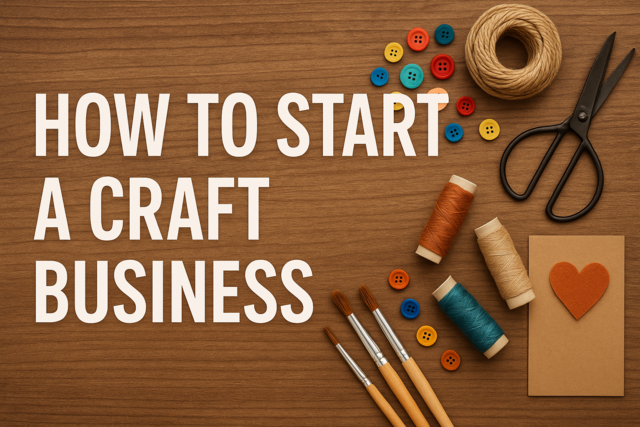Introduction
We realize the financial aspect of a home-based business is not everyone's favorite topic, but it does need to be discussed, at least in brief. When you start your own home-based craft business, you are going to have to know at least the basics about tax obligations, business expenses, and what you can claim as a business deduction. Small business owners are required to fill out a variety of tax schedules and forms at the end of every tax year.
The Internal Revenue Service, more commonly known as the IRS, will expect certain information from you about your business every year. You can not plead confusion or ignorance. It is up to you, as a small business owner, to find out what you are obligated to report, what forms to use, and how you can claim certain deductions for your business at filing time.
An entire course could be developed regarding the IRS, filing taxes, and the responsibilities of large and small business owners, but our goal is only to inform you regarding the basics, such as knowing when and what you may need to pay, determining what may be written off as a home office deduction, and doing your best to reduce your tax obligations.
The Tax Man
If you do not want to deal with learning the ins and outs of your financial obligations regarding your home-based craft business, you can always hire a consultant, a tax lawyer, or a certified public accountant (CPA) to help you with your business planning and tax filing. However, such services cost money, which is often in short supply for beginners in the home-based craft business. But, if you can afford one, their knowledge, experience, and expertise may be well worth the money.
Basically, keep these things in mind:
- Home-based businesses are required to pay income taxes to their state and the federal government. In some cases, you may also need to pay taxes to your city government, depending on location.
- Your tax obligations may differ, depending on the type of business you have designated yourself: a partnership, a limited liability company, a sole proprietorship, a dealer corporation, or a Chapter S corporation. Most home-based businesses are considered sole proprietorships.
- Every U.S. citizen is required to file an annual income tax return, due on April 15. Self-employed or independent contractors, as well as home-based business owners, should pay estimated taxes quarterly throughout the year to help reduce their tax burden on tax day.
- If you claim deductions for your home-based craft business, you need to designate your crafting as a business, and not a hobby.
You can find more information regarding your tax obligations on the IRS website under home-based or home-office startup information.
Different forms must be filled out, depending on the type of business category you designate your craft business under. The most common forms a home-based business owner may fill out include:
- Form 1040 and Schedule C or C-EZ (for income taxes)
- Schedule SE for self employment tax
- Schedule 1040-ES for estimated tax
Self-employed, independent contractors, or self-employed home business owners are generally advised to pay taxes at the same time that income is being earned. Estimated taxes are generally due on April 15, June 15, September 15, and January 15.
As of 2010, the self-employment tax was 15.3%. Just over 12% of that goes toward Social Security, and about 3% goes toward Medicare. For more information on self employment tax, estimated taxes, and how to pay a self employment tax, visit the IRS website at http://www.irs.gov/businesses/small/article/0,,id=98846,00.html.
For example, if you sell $1,000 worth of crafts in one month, you should tuck away 15.3% or $153 of your month's income to send to Uncle Sam. If you sell $3,500 worth of crafts, you would need to tuck away $535. It is a good idea to get into the habit of doing this from the start.
However, many home-based business owners desperately require the income generated from their sales and neglect to do so, figuring that they will be able to do it next month, or the month after. Before you know it, several months have gone by, and you may find yourself having to come up with a rather large amount of money for your estimated taxes.
Maintaining Good Records
One of the best favors you can do for yourself to help keep your financial obligations organized, is to keep good records. Keep any and all receipts on business expenses. For example, if you make a weekly trip to local craft stores or wholesalers for your supplies, keep a record of the amount of money spent on gas doing so. Keep track of phone records for business calls, invoices, and orders. Also keep receipts for shipping, shipping supplies, and any other supplies or tools you need to create your crafts and run your business.
This brings us to the sometimes sticky question of home office deductions. In some cases, you may be able to write off a small area of your home for your business expenses if that area is used exclusively for the performance of your crafting or business operations. Doing so can be complicated and have long-term repercussions, especially when you sell your home, as that office space or crafting space must to be depreciated over time
The most common business deductions that may be recorded on profit and loss statements and business expense forms for the IRS include, but are not limited to:
- Supplies
- Office supplies
- Office furniture or tools and equipment needed for your business
- Internet access expenses
- Postage, mailing, and shipping expenses
- A portion of your phone bill used for business
- A portion of your utilities, again used for business
- Health insurance: self-employed and independent contractors may write off 100 percent of the costs of self-employed or individual health insurance policies
- Business travel expenses, which may include meals and entertainment
Again, keep receipts of anything and everything that you feel has been spent on your business. Use these receipts when filling out your income tax forms, or supply them to your CPA or accountant at tax time. Hang on to these receipts for several years in the event that you are audited.
Sales Tax
Unless you happen to live in Alaska, Montana, Oregon, Delaware, or New Hampshire, your state has a sales tax. If you sell any type of product or crafts to individuals in your state, you should find out whether or not your products are subject to your state's sales tax laws. To do this, you need to do a little research and submit an application with your state's sales tax authority.
Sales tax may be a little confusing. For example, if you sell your handcrafted items at a craft show, you may be required to charge sales tax. However, if you sell a certain number of handcrafted items to a consignment store or retail vendor, you do not have to, as the responsibility falls to the store or business owner, and not yourself. When it comes to selling on the Internet, you do not have to charge for sales tax, as long as your crafts are being shipped outside state lines.
Again, when in doubt, contact your local tax authority to determine your obligations in this regard.
Conclusion
Now that that is out of the way, it is time to learn the basics of growing your business. Reaching the masses is one of the more important aspects of beginning and sustaining a home based craft business, and to do so, you may research a variety of options, including building a website, joining in social networking, learning how to link to craft directories, and blogging.
Reaching The Masses
Creating a Website
Creating a website is fairly essential in the 21st century for anyone who wants to sell a product. Anyone wanting to compete in today's marketplace should have a website. Generation X and the Millennial generation expect large and small businesses to at least have a website that defines the type of products or crafts they are selling, and information about the company, including purchasing and ordering online.
When creating a website, keep in mind the need for search engine optimization, known as SEO. Search engine optimization takes advantage of certain keywords common to your craft or business, and helps increase ranking through their use on your website. For example, if you sell bird houses, common keywords to use throughout your website may include bird houses, bird shelters, houses for birds, and so forth.
Keywords, or keyword phrases, are basically the words that individuals type into a search bar when looking for a product or information. Using keywords and key word phrases throughout your website copy, will help search engines find your website. The better your SEO, the higher you will rank in search engine listings.
Websites can be created by do-it-yourself-ers, or designed by professionals, depending on your budget. Many freelance writing websites offer experienced website builders who can design an effective website for you, based on your budget. However, you can find website-building software at your local office supply store if you want to take a stab at doing it yourself.
A few tips to creating your website include:
- Make your URL (in technical terms; "uniform resource locator"), or website address, easy to remember and spell. Whenever possible, create a name for your website and website address that focuses on the type of craft you offer.
- Include your web site link on all your printed materials and emails, including business cards, invoices, marketing brochures, and so forth. For this reason, try to keep your website address short, concise, and easy to remember.
- Offer a location on your website where visitors can sign a guestbook, leave comments, or provide their contact information for marketing and promotional materials, newsletters, contests, surveys, or feedback.
Social Networking
Social networking websites, such as Facebook and MySpace, as well as Twitter, LinkedIn, and other similar social networking venues, have proved indispensable to many home-based business owners. Social networking is a less formal way of marketing and advertising your business, and can take a number of different approaches when it comes to design.
Linking
Linking to other businesses and listing your website in online business directories, crafting directories, and forums is a great way to spread the word and reach a multitude of individuals in regard to your craft business. Some of the most common online business directories include, but are not limited to:
- directory.google.com
- www. alibaba.com
- search.yahoo.com/dir
- yelp.com
- citysearch.com
The most common social networking sites where you can place links back to your website include:
- facebook.com
- flixster.com
- linkedin.com
- myspace.com
- tagged.com
- twitter.com
Find social networking sites, communities, and friends with the same common interests, especially when it comes to a home-based crafting businesses. In this way, you can extend your marketing, advertising, and reach to individuals not only on the other side of the country, but the other side of the world.
Blogging
Blog marketing is one of the most common trends in Internet marketing today. Blogging on certain websites, such as HomeBasedBusiness.com, enables individuals, friends, acquaintances, and former, as well as future, clients to link into a network of like-minded individuals.
Blogging tools enable home-based craft businesses to post your crafts, videos, and photos on the Internet in a variety of locations, including WordPress.com and BlogSpot.com, and other popular blogging websites.
When you are ready to start blogging, search engine optimize your blogs the same way you search engine optimized your website, to help target individuals searching for certain items or crafts that will be directed toward your website. Your blog should be updated between two and three times a week to keep content fresh. Make your blogs relevant to your craft. For example, you can offer tips of the trade, tips on creating your type of craft, or offer advice to those just entering the home-based crafting business.
When using a blog to help market your crafting business, avoid posting irrelevant blogs regarding your dog, what you did over the weekend, or your plans for the holidays, until you have built up a regular and sustainable audience. Even then, though you want to maintain a certain sense of personality and style in your blog, do your best to keep the blog relevant in order to enjoy long-term readership and greater exposure as a professional blogger.
Conclusion
In today's digital environment, having a website and the blogs is not mandatory, but it is highly recommended in order to compete with other crafters in crafting businesses, not only in your own locality, but in your field. Websites and blogs are used to attract customers and provide information, services, and shipping and handling information, as well as pricing for potential customers.
While creating and maintaining a website, engaging in social networking, or blogging, takes some time and effort, it is well worth it in the end. However, time management is often a difficult concept for home-based craft businesses to master. Learning how to stick to a schedule or deadline can be challenging at times.
























